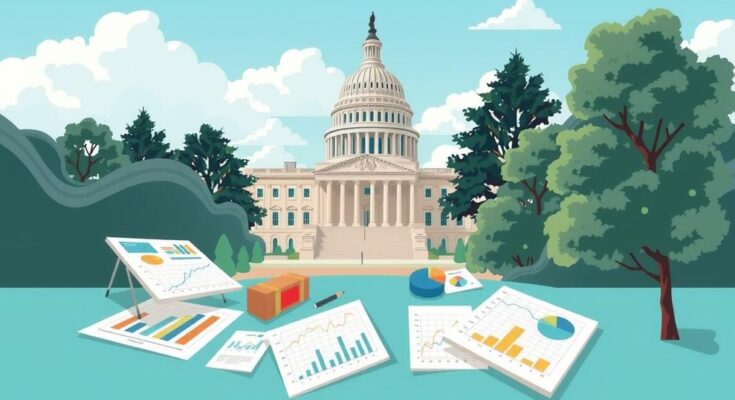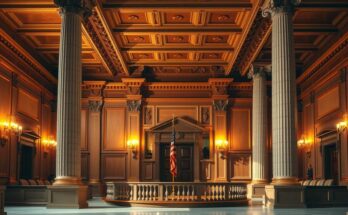This week, Fed Chair Jerome Powell steps into the spotlight on Capitol Hill, amidst an atmosphere charged with political pressure surrounding interest rates. All eyes are on him.
Powell Prepares for a Tense Congressional Testimony
Jerome Powell, the chair of the Federal Reserve, will face Congress this week, stepping into the limelight amid rising political pressures. With interest rate decisions looming, both sides of the political aisle are poised to push for a course correction. His semiannual testimony kicks off Tuesday with the House Financial Services Committee, followed by an appearance before the Senate Banking Committee the very next day. This isn’t just routine; the tension in the air is palpable, as it seems economic issues are entwined with politics more than ever before.
Political Heat on the Federal Reserve
This round of questioning won’t just be about policies or economic indicators. The evolving political landscape – particularly influences from President Trump and his administration – has raised the stakes for Powell. Increasingly, both Republicans and Democrats are eyeballing the recent Fed announcements and questioning what’s holding back a rate cut. Wall Street is buzzing, anticipating what the Federal Open Market Committee might do, especially with notable Fed officials hinting towards easing soon. “There’s some political influence starting to come into the FOMC,” observed Mohamed El-Erian, chief economic advisor at Allianz, showcasing the anxieties that are rising in financial circles.
Speculation Grows Over Rate Cuts
Powell’s message has been clear: the Fed must be patient, waiting to see how the economic winds shift after tariff impacts unfold. However, the recent remarks by Fed Governor Michelle Bowman in Prague and Christopher Waller’s statements on CNBC have sparked speculation about potential rate cuts as early as July. This could indicate a shifting mood within the Fed that has some Wall Street traders adjusting their predictions. Indeed, chances of a July cut have risen to about 23%, while the expected odds for September cuts loom much higher at 82%. All eyes are on Powell as the committee’s cohesion begins to show signs of fracturing, making the upcoming testimonies even more crucial.
Navigating Congressional Minefields
Powell’s two-day session on Capitol Hill is bound to be complicated. His position faces challenges not only from Trump supporters, who want deep cuts, but also from Democrats like Elizabeth Warren who are pushing for similar moves. Traders are keenly aware that whilst Powell has a difficult task ahead, his decisions affect the wider economy significantly. Whether he can maintain the Fed’s independence amidst these conversations remains uncertain. By Thursday, Powell might feel he was under the spotlight more than he bargained for, having to traverse through a minefield of political questions while defending the central bank’s intentions.
Understanding the Risks of Drastic Cuts
But let’s be clear, the calls for drastic movements in interest rates—like the 2 percentage points Trump has suggested—aren’t on the table. Waller highlighted the importance of a gradual approach, emphasising that the Fed is looking at a target rate much more moderate than what is being asked. When you think back to the Fed’s previous cuts, those one-percentage point reductions didn’t result in the expected outcomes. Yields actually went up rather than down, presenting the notion that immediate actions are often misaligned with real-world reactions. “The idea that the Fed does something and there’s immediate transmission is just a myth,” said Jai Kedia of the Cato Institute, really driving the point home.
The Vital Role of the Fed’s Mandate
At the heart of all this is the Fed’s mission—stabilizing inflation and employment, not just catering to political whims. Kedia highlighted the danger in conflating fiscal policies with interest rates, warning that if the Fed bows to political pressure now, their mandate could swiftly be compromised. It’s clear that rates might be too high right now, but the reasoning for cutting them must rely heavily on economic indicators, not political motivations. Kedia went on to state, “A good economic case can be made that the Fed should cut rates, but that’s got nothing to do with the political aspect.” In the end, Powell’s challenge lies in balancing these pressures while keeping a steady course for the economy’s future.
As Powell steps into these crucial hearings, it’s become evident that he is walking a tightrope—balancing intense political pressure while trying to adhere to the core mission of the Federal Reserve. The conversations surrounding potential rate cuts are heavily charged by political currents, with implications for the economy that stretch well beyond Capitol Hill. Navigating through these complexities won’t be easy, but the coming days could prove significant for the direction of monetary policy and economic health moving forward.




